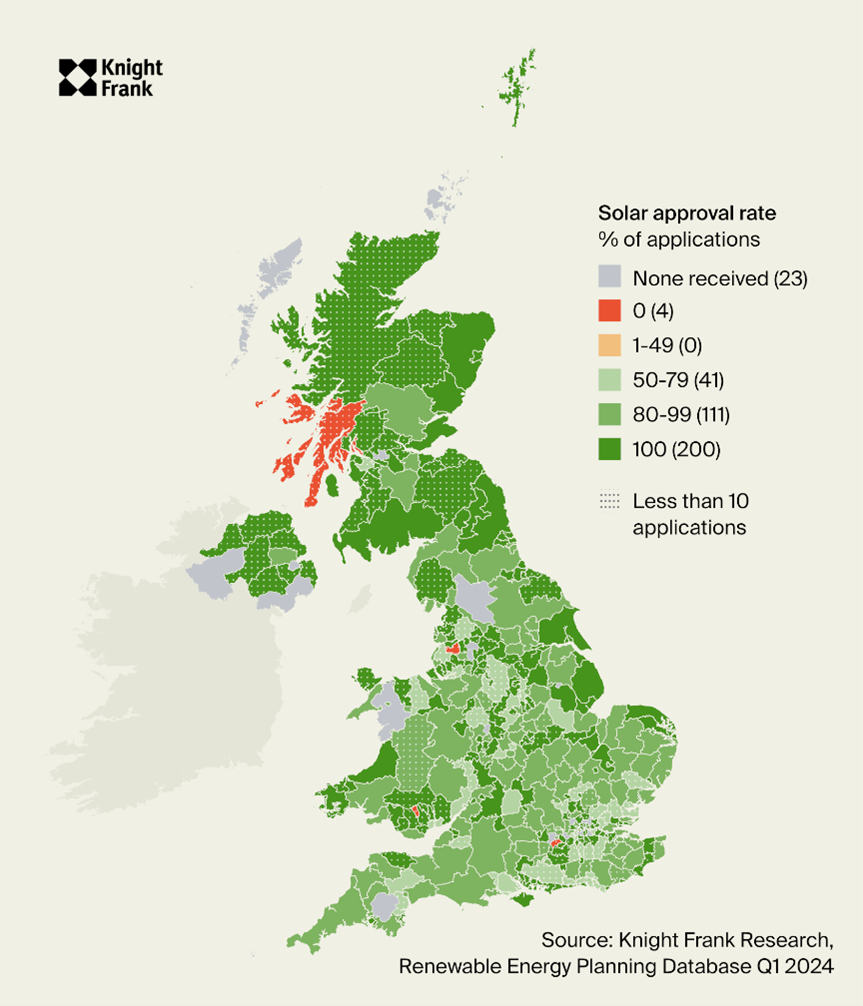Planning for a renewable future
The Labour Party’s manifesto set out a clear desire to decarbonise the UK’s energy infrastructure with a rapid roll-out of renewable projects; the key to this is in planning reform.
3 minutes to read
Renewable Energy front and centre
To meet Labour’s ambitious renewable energy targets, the deployment of onshore wind, offshore wind and solar PV needs to be two to four times faster than in the past five years, something we discuss further here.
The question, then, is how to achieve this uplift. Grid connection is one of the most cited barriers to greater adoption, but the other more immediate issue sits with planning, according to David Goatman, global head of energy, sustainability, and natural resources at Knight Frank.
By potential energy capacity, more than half of the renewable planning applications submitted over the past five years are undetermined, according to analysis of the Renewable Energy Planning Database (REPD). Some 10% have been either abandoned, refused, withdrawn, or expired, and almost 44% are still at the planning submitted stage.
In the past decade, the average time to grant planning for wind projects has been 1.6 years for onshore and 1.7 years for offshore wind; solar photovoltaics (PV) is much faster at a little over four months and batteries take around eight months.
With the new government targeting 35 GW of onshore and 55GW of offshore wind by 2030, even if all current projects under construction, awaiting construction, and planning submitted were completed by 2030, there would still be a shortfall totalling 32GW for onshore and 46.6 GW for offshore. For solar, the shortfall would be almost 8GW, although small household systems, which currently sit at 4.8GW capacity and wouldn’t be included in the REPD, could make up some of this.
Pinch points
Regardless of the time to approve planning, the construction process pushes completion dates out further. According to our analysis, it takes more than two years from a scheme being granted planning permission to it becoming operational for onshore wind and four years for offshore projects. Using this timeline, means that any applications submitted now must receive full planning permission within the next year if they hope to be operational by the 2030 target. Solar PV is slightly quicker, with one year lapsing, on average, between granted and operational. This discounts any potential applications where planning expires; of those submitted in the past decade, around 1GW of solar PV and 0.2GW of onshore wind are in this category.
Where is planning the most significant obstacle? James Pryor has analysed Local Planning Authority (LPA) approval rates for wind and solar applications. Of the 152 LPAs where more than 10 solar applications have gone through, a third have approved all, with 60% approving more than eight in ten. The LPAs with the highest number of approvals include East Riding of Yorkshire, Aberdeenshire and Newcastle upon Tyne.
When it comes to wind applications, 73 LPAs have received more than five submissions, with three approving 100% — East Lothian, Shetland Islands and Bristol — and three-quarters approving more than half of applications. Only five LPAs have approved less than a quarter of those applications received. In terms of those with the greatest number of approvals, Highland, Aberdeenshire and Dumfries and Galloway top the chart.


Thinking differently
The planning process and how we use our space need to be addressed. As we highlighted in our Solar Power Report from December 2023, there is an opportunity for solar deployment on grey, not just green space, such as if the government were to implement policies adopted in France and parts of Germany to install solar panels in car parks. For property owners, there are opportunities for ancillary income through power purchase agreements and boosting the attractiveness to tenants through a proven clean energy supply.
A mammoth task lies ahead, and all the pieces of the puzzle — grid, planning, and viability — must converge to achieve it.